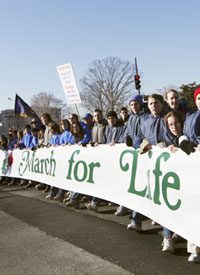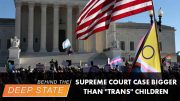
The march started at the Ellipse of the National Mall and continued down Constitution Avenue to the Supreme Court building. It was first held in 1974 to mark the first anniversary of the Supreme Court’s Roe v. Wade decision, in which the Supreme Court ruled unconstitutional all state laws prohibiting abortion. An estimated 50,000,000 babies have been killed in the womb in the United States since the decision was given.
Eileen Picket, an elementary school teacher from Connecticut, explained her reasons for coming to the event to a reporter from ZENIT news service the night before the march : “We have a new president who has tremendous power to change the pro-life direction of the United States. Our country needs to say that abortion is a terrible crime that kills innocent humans and we have to pray so that this new administration has the foresight to accept this.”
Approximately 16,000 young people — mostly students from church-affiliated colleges — spent the night before the march sleeping at the adjacent campuses of the Catholic University of America and the National Shrine of the Immaculate Conception in Northeast D.C. Thousands of them, along with many priests, nuns, and other clergy, gathered on the morning of the march at the 18,000-seat Verizon Center for a pro-life rally featuring Christian musical performers.
Anna Alikhani, a 17-year-old high-school junior at the Academy of the Holy Cross in Kensington, Maryland, told a Washington Post reporter that she and her classmates had spent several weeks in a Christian lifestyle course that included affirmation of chastity, the history of Roe v. Wade, and President Obama’s voting record as a state and U.S. senator from Illinois.
“It’s tough,” Miss Ailikani told the Post. “All we can do is keep praying for the president, and hope he hears our message today.”
The young people joined thousands of other pro-life supporters for a rally on the Capital Mall at noon, where they listened to dozens of distinguished speakers. Nellie Gray, the founder and president of the March for Life, served as the master of ceremonies for the event.
A sizeable number of members of Congress addressed the crowd, included Republican Senators David Vitter of Louisiana and Sam Brownback of Kansas. Representatives included Jim Sensenbrenner (R-Wis.), Chris Smith (R-N.J.), Roscoe Bartlett (R-Md.), Todd Akin (R-Mo.), Jean Schmidt (R-Ohio), Paul Broun (R-Ga.), Steve King (R-Iowa), Jim Jordan (R-Ohio), Gregg Harper ( R-Miss.), Henry Brown (R-S.C.), Robert Aderholt (R-Ala.), Mary Fallin (R-Okla.), Phil Roe (R.-Tenn.), Jeff Fortenberry (R-Neb.), Jack Kingston ( R-Ga.), Bob Latta (R-Ohio), Bob Inglis (R-S.C.), Glenn Thompson (R-Pa.), Pete Olson (R-Texas), Todd Tiahrt (R-Kan.), Michelle Bachmann (R-Minn.), and Trent Franks (R-Ariz.).
The March for Life showed its ecumenical colors as clergy and lay people from a wide variety of religious affiliations addressed those gathered on the Capital Mall. These included Metropolitan Jonah of the Orthodox Church in America, who in turn introduced Archbishop Nicolae of the Romanian Orthodox Church in America.
Anglicans for Life president Georgette Forney and Priests for Life executive director Janet Morana, who are cofounders of the “Silent No More” awareness campaign (a national effort to assist women who have had abortions to share their testimonies), addressed the large crowd in which were many signs reading “I regret my abortion.”
Perhaps the most dynamic speaker at the event was Pastor Luke J. Robinson of the Quinn Chapel African Methodist Episcopal Church in Frederick, Maryland. Pastor Robinson addressed much of his message to President Barack Obama, observing that the nation’s first African-American president is also committed to abortion. Robinson cited the disproportionate number of abortions (34 percent) that are performed each year on black American women, who comprise just 12 percent of the population. “Every day people of your ethnic background and of my ethnic background die in staggering numbers,” noted Robinson, in an open address to the president.
Another animated speaker was Orthodox Jewish Rabbi Yehuda Levin, founder of Congregation Mevakshei Hashem (Those Who Seek the Lord) Synagogue in Brooklyn, New York.
Cardinal Justin Rigali, archbishop of Philadelphia and chairman of the Catholic Bishops’ Committee on Pro-Life Activities, introduced many of his fellow bishops who had joined him on the platform, including Cardinal Shawn O’Malley of Boston. Earlier the same day, Rigali had offered a Mass for the marchers in the National Basilica of the Immaculate Conception.
Another speaker, Bobby Schindler, the brother of the late Terri Schiavo, reminded the attendees that the right to life was not just about abortion, but also included the right of the incapacitaed to be allowed to die naturally.
Though the primary focus of the annual March for Life to call attention to public opposition to Roe v. Wade, signs seen among the marchers this year include many reading “fightFOCA.com.” FOCA, the so-called Freedom of Choice Act, was legislation introduced in the previous (110th) Congress declaring “that it is the policy of the United States that every woman has the fundamental right to choose to bear a child; terminate a pregnancy prior to fetal viability; or terminate a pregnancy after viability when necessary to protect her life or her health.” FOCA sought to prohibit federal, state, or local governmental entity from denying or interfering with a woman’s “right” to an abortion and opened the door to litigation against any government entities violating the act.
Many pro-life organizations have quoted a promise Barack Obama made to Planned Parenthood last year: “The first thing I’d do as President is sign the Freedom of Choice Act. That’s the first thing I’d do.”
While FOCA has yet to be introduced in the 111th Congress and, therefore, signing it obviously cannot be the first thing President Obama does, it is undeniably a heinous piece of legislation that would violate both human life and states’ rights, and should be vigorously opposed. However, the connection between states rights and human life escapes many in the pro-life movement and it is worth recalling that — as with many other violations of states’ rights — Roe v. Wade was first and foremost a misapplication of the 14th Amendment, which (quite ironically) states that “nor shall any State deprive any person of life, liberty, or property, without due process of law.” (Emphasis added.) Therefore, an amendment originally passed to protect life has been twisted to justify destroying life!
Ever since the Roe v Wade (and the less publicized Doe v. Bolton) decision, the primary strategy among pro-life people has been to overturn Roe by electing so-called pro-life Republican presidents who will theoretically appoint strict constructionist justices to the Supreme Court. Thirty-six years later, abortion for any reason throughout all nine months of pregnancy remains legal everywhere in the United States.
However, there exists a simpler, more practical strategy provided for in Article III, Section 2 of the U.S. Constitution that would allow Congress to strip the Supreme Court (and all federal courts) of their power to decide on abortion and any other matters our legislature decides. It would make Roe v. Wade redundant overnight.
In an online article for tomorrow, this writer will describe this remedy, which has already been introduced by Rep. Ron Paul (R.-Texas) in the new (111th) Congress as H.R. 539, the “We the People Act.” H.R. 539 would remove jurisdiction of the Supreme Court over cases related to the free exercise of religion, sexual practices, or reproduction (abortion).
See also “Ron Paul’s Approach to Reversing Roe v. Wade.”
Photo: AP Images



